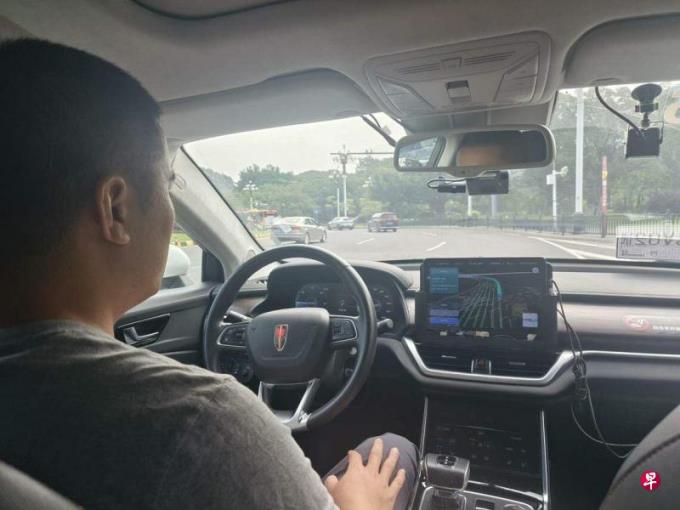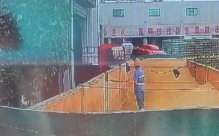
As one of the three major automobile production bases in China, Guangzhou proposed to create the development goal of the world's well -known trillion -level "smart car city", which is accelerating the research and development and promotion of technologies such as connected vehicle and autonomous driving.
The site on Daguan Road, Huangpu District, Guangzhou, use mobile phone software to set the starting point and end point position. After a few seconds, the order display is confirmed.Three minutes later, a red flag brand's self -driving taxi (Robotaxi) slowly came and stopped at the starting point.
From the perspective of appearance, this self -driving taxi is not much different from ordinary taxis. Mixing with other social vehicles on the road, it is easy to ignore the sensor equipment on the roof.Because you can only sit in the back row, you can carry up to three people in the car. After getting on the car to confirm the information of the passenger, the safety officer in the car reminds the passengers to wear a seat belt, and the vehicle starts to start.
The car is equipped with a safety officer to observe the driving conditions throughout the process
During the driving process, there is no need to operate the driver throughout the process. However, according to the pilot management requirements of the commercialization pilot service of Guangzhou's autonomous driving travel service, the inside of the car must still be equipped with a safety officer to sit in the main driving position to observe the driving conditions throughout the process.
The security officer did not touch the steering wheel with both hands, but kept staying near the steering wheel.He told Lianhe Zaobao that before each security officer was on his job, he had undergone strict training and assessment. There was no driving behavior during driving. Only when emergency occurred, would they intervene.
ROBOTAXI is steadily driving throughout the process, and flexibly avoid and change the road in the traffic. Due to the speed limit requirements, the speed is lower than normal vehicles.The journey of more than six kilometers, 15 minutes long, and normal charges of about 36 yuan (the same, about S $ 6.7), but because of the first time in the preferential period, the reporter finally paid only 3.58 yuan.
This is the autonomous vehicle of the Baidu radish running Robotaxi in Guangzhou. It operates in the designated area of the city and is also one of the vehicles participating in the autonomous driving demonstration operation.In 2018, Guangzhou began the layout of the development of intelligent vehicles. In 2019, the first batch of autonomous road testing licenses were released, and subsequent expansion of road test scope and main body.As of now, Guangzhou has issued road test licenses to 348 smart connected cars such as Xiaoma Zhixing, Wenyuan Zhixing, Baidu Apollo, GAC Group, Xiaopeng Zhixing, and Xiaopeng Zhixing.
In the autonomous driving operation service area, ROBOTAXI is already a choice of travel methods for local people. Although there are still safety officers in the car, Robotaxi, which is "unattended", has emerged.
From April, Guangzhou has allowed safety officers to "intellectual car" on the road
From April this year, Guangzhou began to allow safety -free driving taxis to go on the road, which also means that the self -driving road test has entered a new stage.The headquarters of Guangzhou Xiaoma Zhixing Technology Co., Ltd. was awarded the first remote passenger license to open the autonomous driving service without safety officers in Nansha District.During driving, passengers can assist experts in real time in real time in the car to get remote assistance support.
In addition to autonomous driving taxis, unmanned Robobus also provides bus services in Guangzhou, and driverless sanitation vehicles and unmanned cargo vehicles have also been put into operation.
The relevant person in charge of the Guangzhou Haizhu District Government told the United Zard that in 2021, Guangzhou plans to open the first batch of six autonomous bus public transportation public demonstration operation lines to create a demonstration operation project of Guangzhou intelligent connected car. Among them, the line located in Haizhu District has already beenThe public beta was launched in 2022, providing connection services from subway stations, tram stations, and parking lots to work locations to facilitate the last mile commuting of citizens.
The person in charge pointed out that in the Pazhou Artificial Intelligence and Digital Economic Pilot Zone in Haizhu District, more smart transportation application scenarios are currently planning and exploring the landing of more smart transportation application scenarios, such as the smart intersection and the AVP independent passenger parking system that solves the problem of parking.(Automated VALETPARKING), etc.
The major cities seize the autonomous driving highland Guangzhou wants to build an international "smart car city"
Autonomous driving is known as the "Pearl in the Crown of Artificial Intelligence". The market space is huge. In recent years, in addition to car companies and technology companies, major cities in China are accelerating the exploration of autonomous driving.Chain development, seize the highlands of lured driving.
According to the Beijing News, incomplete statistics show that more than 40 provinces and cities including Beijing, Shanghai, Guangzhou, Shenzhen, Chongqing, and Changsha have actively issued corresponding management measures or implementation rules., Demonstrating operations to multiple stages such as unmanned development to carry out active exploration.
Guangzhou is an important base for China's automobile industry. Laying out in the field of intelligent connected automobiles is the city that China has carried out autonomous driving test earlier.5G remote driving test, the first recognition of other regions of intelligent connected car road test permits, the first introduction of the commercialized operation policy of autonomous driving, etc. Guangzhou is currently accelerating the development of autonomous driving, connected applications and vehicle road collaborative industries to form formationSafe and autonomous automotive industry chain supply chain.
Based on the development goals of Guangzhou, by 2025, Guangzhou will realize the output value of the automobile manufacturing industry above designated size and create a world -renowned "city of think car".
Sun Zhiyang, the former mayor of Guangzhou, who just played in October, has a close relationship with the automotive industry. He has worked in China FAW Group for many years and is responsible for the development of the Guangdong automotive industry chain during his period of time as the deputy governor of Guangdong Province.Sun Zhiyang's rich experience in the automotive field has also made the outside world more imaginative space for the development of Guangzhou's "City of Thoughts".
Weride, headquartered in Guangzhou, told United Morning Post that Guangzhou's open policy environment and perfect automotive industry chain supporting facilities are important factor to attract enterprises.
The person in charge of Wenyuan Zhiqi said that Guangzhou has always adopted an open policy permit to create a loose business environment, promote the development of the intelligent connected automobile industry, and establish the "Belt and Four Districts and Regional Interconnection in the coordinated construction of vehicle roads."The overall pattern, which brings great confidence to the commercialization of autonomous driving products.
Analysis: Solid foundation in Guangzhou's automotive industry
Hao Xinhua, director of the Industrial Center of the Guangzhou Urban Development Planning Institute, analyzed in an interview with Lianhe Morning Post that Guangzhou's automotive industry was solid.In 2022, Guangzhou's vehicle production reached 3.136,800 vehicles, ranking first in cities across the country for many years.In addition, the total output value of Guangzhou in Guangzhou accounted for nearly 70 % of the total output value of the province's automotive industry, and the huge large -scale production scale, forming a huge industrial cluster in Guangzhou and surrounding areas.
In terms of innovation capabilities, Hao Xinhua pointed out that Guangzhou's automotive industry has strong innovation. There are about 196 national and provincial engineering technology centers and laboratories related to the automotive industry in Guangdong Province.Home.In addition, Guangzhou has gathered a number of cutting -edge autonomous driving enterprises. Policy innovation has always been at the forefront of the country. These are the advantages of Guangzhou to develop autonomous driving.
At the same time, the development of Guangzhou's autonomous driving field is also facing obvious challenges.Hao Xinhua pointed out that the Guangzhou automobile industry is traditional, and the intelligent network connecting new energy field has developed slowly. In 2022, the output of new energy vehicles in 2022 is 313,700 units, ranking only the eighth nationwide.The development of smart driving hardware such as sensors, smart cockts is lagging behind.
In addition, Guangzhou's autonomous driving enterprise has a weak industrialization.Hao Xinhua said that Baidu's Baidu Apollo, Wenyuan Zhixing, Xiaoma ZhixingEnterprises focusing on autonomous driving in the field of ROBOTAXI, and cooperation with local vehicle manufacturing companies such as GAC and Xiaopeng, in August this year, Xiaoma Zhixing, Toyota, and GAC jointly established new enterprises to promote the mass production of Robotaxi.But this model is mainly for business operations.
In the Advanced Driver Assistance Systems (ADAS), Guangzhou's progress is slower than that of commercial vehicles.Hao Xinhua pointed out that the existing car companies in Guangzhou are mainly focused on the autonomous driving field of commercial vehicles such as Robotaxi. The layout of the ADAS field is weak. In contrast, Huawei's personal passenger vehicle autonomous driving system is mainly equipped in the private car field.It is easy to expand the market size.
The commercialized roadblocks of autonomous driving are to break through
With the accelerated development of intelligent connected cars and autonomous driving industries, autonomous driving has shifted from the test stage to the commercial operation stage, and gradually changes people's travel methods and lifestyle.However, there are still many problems to break through autonomous driving to truly realize commercialization.
From the perspective of the autonomous driving technology company Wenyuan Zhixing, in terms of technology, the stability and reliability of the self -driving solution of the software and hardware integration, which requires participants with different characters in the industry chain.It is necessary to start multi -party coordinated cooperation. The production of front -loading is the key to realizing the large -scale operation of L4 (see table).
The person in charge of Wenyuan Zhixi told United Morning Post that in terms of cost, whether the return on investment (ROI) meets market demand and expectations is related to multiple factors, including reducing hardware costs such as laser radar and labor cost staff labor costs., And to improve the reuse of algorithms, reduce research and development costs, etc.
Policy is also one of the obstacles to the rapid development of autonomous driving, including practical problems such as cars cannot enter the market, cannot operate charges, and difficult to determine accident responsibilities.The above -mentioned person in charge stated that there are currently different policies such as the access permits and operation scope of autonomous driving in various places. To solve the obstacles, relevant departments and enterprises need to be promoted.
Chen Xijiu, Minister of Industry Research Center of the Guangzhou Urban Planning Survey and Design and Research Institute, analyzed to Lianhe Zaobao, due to factors such as the degree of policy openness, legal system and technical maturity, the fields of autonomous driving such as Robobus and Robotaxi are still in large -scale scaleIn the short term, it is difficult for autonomous driving companies to achieve economic balance in the short term. However, in the high -end auxiliary driving field of ADAS, the market will quickly enter the realization stage.
Chen Xijin pointed out that from the current trend of technology and policies, it is expected that after 2025, with the gradual improvement of the legal system, Robobus and Robotaxi will gradually enter the public life larger, compared to Robobus and andRobotaxi, high -end intelligent driving in the field of private passenger cars will be popular among the public faster.
Chen Xijiu is more optimistic about the development of ADAS enterprises. He pointed out that while maintaining frontier research and development innovation, autonomous driving enterprises to launch ADAS related products in the field of passenger cars in a timely manner will help improve economic benefits and improve influence.



